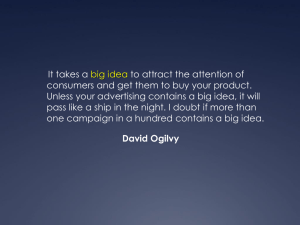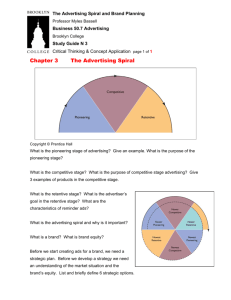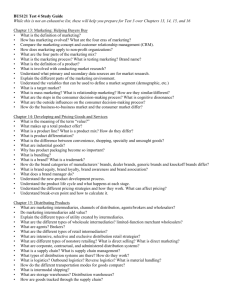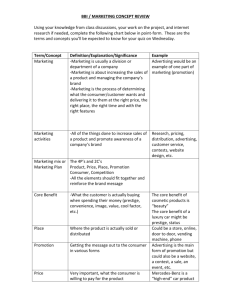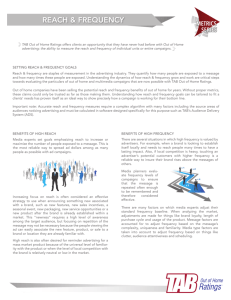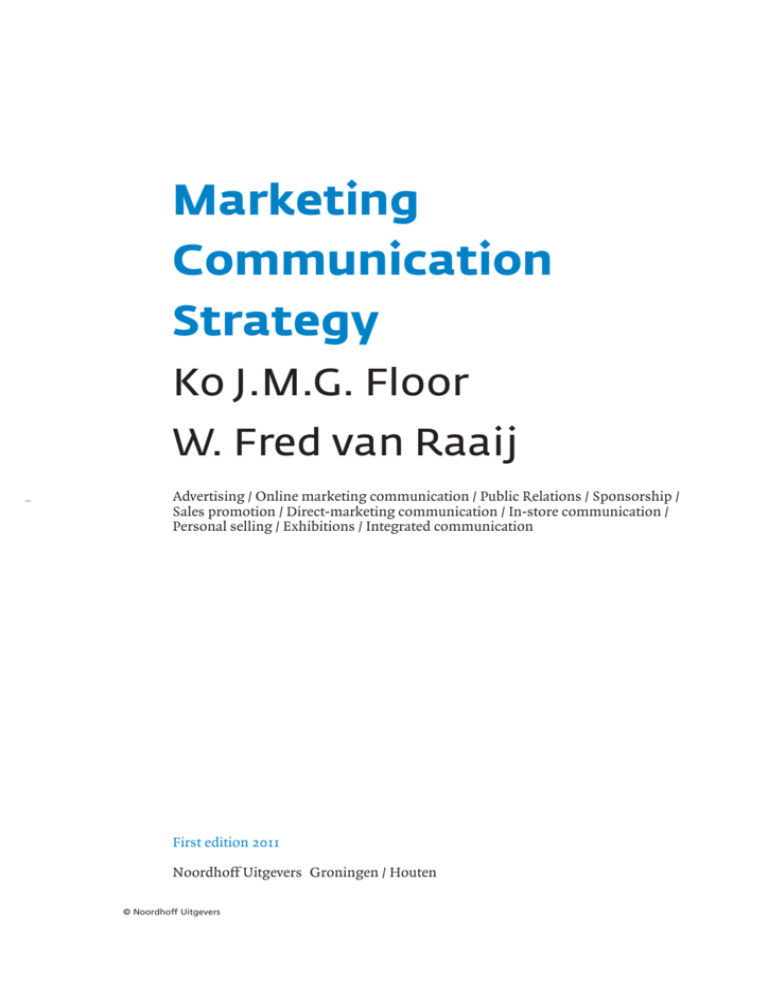
Marketing
Communication
Strategy
Ko J.M.G. Floor
W. Fred van Raaij
Advertising / Online marketing communication / Public Relations / Sponsorship /
Sales promotion / Direct-marketing communication / In-store communication /
Personal selling / Exhibitions / Integrated communication
First edition 2011
Noordhoff Uitgevers Groningen / Houten
© Noordhoff Uitgevers
Cover design: G2K Designers, Groningen/Amsterdam
Cover illustration: © Studio Ari Versluis & Ellie Uyttenbroek, Exactitudes ®
Any comments about this publication or others may be addressed to:
Noordhoff Uitgevers bv, Afdeling Hoger Onderwijs, Antwoordnummer 13,
9700 VB Groningen, e-mail: info@noordhoff.nl
Despite strenuous effort, it has proven impossible to trace all those who possess copyrights
to the texts and/or illustrations. Anyone who believes that (s)he possesses such copyrights
is requested to contact the publisher.
0 1 2 3 4 5 6 / 15 14 13 12 11
© 2011 Noordhoff Uitgevers bv Groningen/Houten, The Netherlands.
Subject to the exceptions in or pursuant to the Auteurswet (Copyright Act) of 1912, no part
of this publication may be reproduced, stored in an automated retrieval system or made
public in any way, either by electronic or by mechanical means, by photocopying, recording
or otherwise, without the prior written permission of the publisher. To the extent that
reprographic reproduction of this publication is permitted pursuant to Article 16h
Auteurswet 1912 (Copyright Act 1912), the compensation payable is to be made to the
Stichting Reprorecht (postbus 3060, 2130 KB Hoofddorp, www.cedar.nl/reprorecht).
Anyone wishing to reproduce part(s) of this publication in anthologies, readers and other
compilations (Article 16 Auteurswet 1912) may apply to the Stichting PRO (Stichting
Publicatie- en Reproductierechten Organisatie, P.O. Box 3060, 2130 KB Hoofddorp,
www.cedar.nl/pro).
All rights reserved. No part of this publication may be reproduced, stored in a retrieval system, or transmitted, in any form or by any means, electronic, mechanical, photocopying, recording, or otherwise,
without the prior written permission of the publisher.
ISBN 978-90-01-78256-6
NUR 802
© Noordhoff Uitgevers
Introduction
Marketing communication is constantly developing. This book, therefore, requires
the description of new media and new examples. Traditional printed media, radio
and television remain important media in the marketing communication plan. But
alongside these traditional media new, internet-based media are emerging, such as
websites, weblogs, emails, Facebook and Twitter. It is consumers who decide on the
content of the online social media such as Facebook, Hyves and Twitter. Advertisers
have far less control over these online media than over traditional media.
For traditional media advertisers can design a media plan to specify what they want
to achieve during a certain period in terms of brand awareness, brand preference
and sales. This is far less easy to do for the new online social media. Information
must be available and easy to find for consumers. On the internet consumers must
be able to find quick answers to all their questions and queries and in many cases
they must be able to compare products. They must also be able to find where these
products are available, where they are sold and how they can be ordered on the
internet. What matters especially is anticipating changing trends and preferences.
The brand must be up to date and relevant and remain interesting to consumers.
In chapter 14, special attention has been paid to online marketing communication.
We are grateful to Coby van Maanen-Tetteroo and Hans van der Meulen for their
help in writing this chapter.
Every day consumers are overloaded with all kinds of marketing communication. All
these messages compete for attention, but only a small proportion of all
communication really ‘touches’ the consumer. In order to make the chance of
‘touching’ as large as possible, an approach is needed which comprises theory and
practice, which shows what ‘works’ and what does not ‘work’. This book aims to
formulate such an approach. Step by step it describes how a solid marketing
communication plan can be drawn up.
In this book all marketing communication methods will be discussed, with many
examples to clarify the theory and to illustrate the descriptions.
We hope that consumers, teachers and students will have the same pleasure in
reading this book as we had in writing it. In doing so we have benefited enormously
from information and ideas supplied by numerous colleagues, teachers, students
and others. Articles in magazines such as Adformatie and Marketing Tribune
supplied us with additional input. We are most grateful to their authors. Without
their input, this book would have been far less comprehensive.
On the www.marketingcommunicationstrategy.noordhoff.nl site you will find a
large quantity of supporting and additional material. This site is regularly updated in
order to include the (online) developments that were referred to at the beginning of
this introduction.
Ko Floor and Fred van Raaij
Landsmeer / Alphen, N.Br., June 2010
© Noordhoff Uitgevers
Abbreviated table of contents
Part 1 Marketing and communication 1
1
2
3
Marketing communication and other marketing methods 2
The communication mix of a company 28
Criticism and regulation 50
Part 2 Marketing communication plan 81
4
5
6
7
8
9
10
11
12
Components of the marketing communication plan 82
Research into consumers, products and competition 94
Marketing communication target groups 118
Marketing communication objectives 136
Marketing communication strategy 156
Creative development 182
Marketing communication budget 208
Communication research 224
Relationship client and communication agency 244
Part 3 Marketing communication
instruments 271
13
14
15
16
17
18
19
20
21
Advertising 272
Online marketing communication 300
Public relations and information extension 324
Sponsorship 342
Sales promotion 362
DM communication 394
In-store communication 418
Personal selling 442
Exhibitions 458
Part 4 Media 475
22
23
24
Media types 476
Media plan and media selection 498
Media research 520
Part 5 Integration of the marketing
communication mix 537
25
Integrated marketing communication 538
© Noordhoff Uitgevers
Table of contents
Introduction
Part 1
Marketing and communication 1
1
Marketing communication and other
marketing methods 2
1.1
Importance of a strong brand 4
1.1.1
Functions of a brand for consumers 5
1.1.2
Functions of a brand for companies 5
1.1.3
Brand image 6
Changes in marketing communication 8
1.2.1
Direct contact with customers 8
1.2.2
Communication through retailers 8
1.2.3
Looking for distinctive features 8
1.2.4
First direct advertising campaigns 8
1.2.5
Large advertising budgets 9
1.2.6
More marketing communication methods 9
1.2.7
One-to-one communication 9
Product, brand and communication 10
1.3.1
Types of products 11
1.3.2
Brand name 13
1.3.3
Brand strength 15
1.3.4
Packaging 17
Price and communication 18
1.4.1
Tension between producers and retailers 18
Distribution and communication 20
1.5.1
Types of distribution 21
1.5.2
Collaboration 22
1.5.3
Seeking an identity 23
1.5.4
Contact with buyers 24
1.5.5
Push and pull 24
Transaction and relationship 25
Summary 27
1.2
1.3
1.4
1.5
1.6
© Noordhoff Uitgevers
2
The communication mix of a company 28
2.1
2.2
Corporate and marketing communication 30
Characteristics of corporate communication 31
2.2.1
Customers and prospects 33
2.2.2
Government and politics 34
2.2.3
Present and potential employees 35
2.2.4
Labour market 36
2.2.5
Financial world 37
2.2.6
Public opinion 38
Marketing communication instruments 39
Some definitions 42
2.4.1
Marketing communication 42
2.4.2
Advertising 43
2.4.3
Propaganda 45
2.4.4
Public relations 45
2.4.5
Sales promotion 46
Need for integration 46
2.5.1
Synergy 47
2.5.2
Organizational measures 48
Summary 48
2.3
2.4
2.5
3
Criticism and regulation 50
3.1
3.2
Criticism of marketing communication 52
Higher price 52
3.2.1
Influence on cost price 53
3.2.2
Role of retailers 54
3.2.3
Price level of a product group 56
Restricting competition 56
3.3.1
Formation of monopolies 56
3.3.2
Loss of market leadership 57
Pseudo-needs and undesirable spending patterns 58
3.4.1
Undesirable spending patterns 59
3.4.2
Tobacco advertising ban 59
3.4.3
Alcohol advertising ban 60
3.4.4
Environment 60
Irritation 61
3.5.1
Insult to intelligence 61
3.5.2
Poor taste 61
3.5.3
Pseudo-reality 61
3.5.4
Confirmation of stereotypes 62
3.5.5
Criticism of television advertising 62
Deceptive marketing communication 63
3.6.1
Different opinions 63
3.6.2
Forms of deception 64
Legislation 65
3.7.1
Law on Deceptive Advertising (LDA) 65
3.7.2
Law on Games of Chance 66
3.7.3
Sweepstakes 66
3.7.4
Law on the Protection of Personal Data (LPPD) 66
3.7.5
Benelux Treaty on Intellectual Property (BTIP) 67
3.7.6
Food and Drugs Act 68
3.3
3.4
3.5
3.6
3.7
© Noordhoff Uitgevers
3.8
3.9
3.7.7
Copyright Act 69
3.7.8
Media Law 69
3.7.9
Comparative advertising 70
Advertising Standards Authority 71
3.8.1
General rules of conduct 72
3.8.2
Special rules of conduct 72
Public service advertising 75
Summary 77
Part 2
Marketing communication plan 81
4
Components of the marketing communication
plan 82
4.1
Need for a strategic marketing communication plan 84
4.1.1
Planning period 84
4.1.2
Advantages of strategic planning 84
From company plan to marketing communication plan 85
4.2.1
Company plan 86
4.2.2
Marketing plan 87
Strategic marketing communication plan 87
4.3.1
Research into consumers, products and competition 89
4.3.2
Marketing communication target groups 89
4.3.3
Marketing communication objectives 89
4.3.4
Marketing communication strategy 90
4.3.5
Choice of marketing communication mix 91
4.3.6
Creative development 91
4.3.7
Choice of media 91
4.3.8
Marketing communication budget 92
4.3.9
Communication evaluation 93
Summary 93
4.2
4.3
5
Research into consumers, products and
competition 94
5.1
5.2
Importance of research 96
Phase models of communication effects 97
5.2.1
Purchase Involvement 97
5.2.2
External and internal pacing 99
5.2.3
Dissonance-attribution hierarchy 99
5.2.4
Scanning and focusing 101
Values and meanings 102
5.3.1
Means–end chain 103
5.3.2
Importance of benefits for marketing communication 105
Types of product and marketing communication 108
5.4.1
FCB matrix: knowledge, emotion and involvement 108
5.4.2
R&B matrix: informational and transformational functions 110
5.4.3
Processing strategies 110
Strong and weak points of the competition 112
5.3
5.4
5.5
© Noordhoff Uitgevers
5.6
Product and brand life-cycles 113
5.6.1
Product life-cycle 113
5.6.2
Brand life-cycle 115
Summary 116
6
Marketing communication target groups 118
6.1
Marketing and communication target groups 120
6.1.1
Segmentation 121
General level 122
6.2.1
Geographic characteristics 122
6.2.2
Socio-economic characteristics 122
6.2.3
Psychological characteristics 124
6.2.4
Product ownership 124
Domain-specific level 125
6.3.1
Involvement 125
6.3.2
Required product characteristics and benefits 125
6.3.3
Product ownership and product use 126
6.3.4
Nature of product use 127
6.3.5
Momentary consumers 127
Brand-specific level 127
6.4.1
Brand awareness 127
6.4.2
Knowledge and attitudes 128
6.4.3
Buying intentions 128
6.4.4
Buying and usage behaviour 128
6.4.5
Pyramid of customer groups 131
Roles in the decision-making process 132
Summary 134
6.2
6.3
6.4
6.5
7
Marketing communication objectives 136
7.1
Why objectives? 138
7.1.1
Types of objectives 138
7.1.2
Positioning 139
7.1.3
Advantages of communication objectives 139
Marketing objectives versus communication objectives 139
Communication objectives 141
7.3.1
Category need 142
7.3.2
Brand awareness 143
7.3.3
Brand knowledge 145
7.3.4
Positive brand attitude 146
7.3.5
Behavioural intention 147
7.3.6
Behaviour facilitation 148
7.3.7
Behaviour 148
7.3.8
Satisfaction 149
Choice of communication objective 150
Making objectives measurable 151
7.5.1
Practice 152
DAGMAR model 153
7.6.1
Criticism 155
Summary 155
7.2
7.3
7.4
7.5
7.6
© Noordhoff Uitgevers
8
Marketing communication strategy 156
8.1
Positioning 158
8.1.1
Supporting the promise 158
8.1.2
Competition and reputation 163
Importance of good strategy 164
Different marketing communication strategies 166
Communication strategy for a new product 167
Communication strategy for a growing product 170
8.5.1
Emphasizing distinctive functional benefits 170
8.5.2
Adding psychological meaning 171
Communication strategy for a mature product 171
8.6.1
Ensuring high and spontaneous brand awareness 172
8.6.2
Emphasizing better performance than other brands 172
8.6.3
Emphasizing similar performance at a lower price 173
8.6.4
Drawing attention to product improvements 174
8.6.5
Strengthening psychological meaning 177
8.6.6
Reinforcing satisfaction 177
Communication strategy for a product in its final phase 178
8.7.1
Communicating radical product changes 179
8.7.2
Drawing attention to new applications 179
8.7.3
Increasing usage frequency 179
8.7.4
Attracting new target groups 179
Summary 180
8.2
8.3
8.4
8.5
8.6
8.7
9
Creative development 182
9.1
Phases in creative development 184
9.1.1
Proposition 184
9.1.2
Concept 185
9.1.3
Execution 185
Briefing 186
9.2.1
Strategy and present position of the brand 186
9.2.2
Description of the target group 186
9.2.3
Communication objectives 187
9.2.4
Proposition 187
9.2.5
Style: guidelines for text and design 189
9.2.6
Choice of communication instruments and media 190
9.2.7
Budget 190
9.2.8
Time planning 191
Creative concept 191
9.3.1
Comparative concept 191
Concept and execution 193
9.4.1
Design and layout 194
9.4.2
Typography and colour 194
9.4.3
Language and style 194
9.4.4
Music 195
9.4.5
Image and text 195
9.4.6
Testimonials 196
9.4.7
Drama 196
9.4.8
Lesson 197
9.4.9
Fear 197
9.4.10 Humour and eroticism 197
9.4.11
Presenters 197
9.4.12 Advertising properties 198
9.2
9.3
9.4
© Noordhoff Uitgevers
9.5
9.6
9.7
Creativity 199
9.5.1
Choosing the right person 200
9.5.2
Managing the creative process 200
9.5.3
Improving the creative climate 201
9.5.4
Testing the result 201
Presentation to the client 202
9.6.1
Assessment criteria 202
Execution of an advertisement 204
9.7.1
Components of an advertisement 204
Summary 206
10 Marketing communication budget 208
10.1 Big company budgets 210
10.2 Factors influencing the budget 210
10.2.1
What is assigned to the communication budget 211
10.2.2 Role of marketing communication in the marketing process 211
10.2.3 Size of the market 211
10.2.4 Product life-cycle 212
10.2.5 Product features and differentiation 212
10.2.6 Profit margin and turnover 213
10.2.7 Activities of competitors 213
10.2.8 Media costs 214
10.3 Budgeting methods 214
10.3.1
Proportion-of-turnover method 214
10.3.2 Closing-entry method 216
10.3.3 Parity method 216
10.3.4 Goal-setting method 217
10.3.5 Adjustment of the communication budget 219
10.4 Anti-cyclical budgeting 219
Summary 221
11 Communication research 224
11.1
11.2
11.3
11.4
11.5
11.6
Types of communication research 226
Communication strategy research 227
11.2.1
Background research 228
11.2.2
Quantitative research 228
11.2.3
Qualitative research 229
Concept research 230
Pre-tests 231
11.4.1
Establishing process effects 231
11.4.2
Selecting among communication messages 232
11.4.3
Determining placement frequency 232
11.4.4
External validity 232
11.4.5
Pre-test methods 233
Post-tests 237
11.5.1
Medium reach 237
11.5.2
Processing effects 237
11.5.3
Behavioural effects 239
Communication evaluation research 240
11.6.1
Changes in brand awareness, knowledge, attitude and buying
intention 240
11.6.2
Changes in individual buying behaviour 241
11.6.3
Changes in sales levels and market share 241
Summary 241
© Noordhoff Uitgevers
12 Relationship client and communication agency 244
12.1
12.2
12.3
12.4
12.5
12.6
12.7
12.8
12.9
12.10
12.11
Dutch communication agencies 246
12.1.1
The American wave 246
12.1.2
Mergers and acquisitions 247
12.1.3
The big agencies 247
Trade associations 247
12.2.1
Association of Communication Agencies 247
12.2.2 Pragma 248
12.2.3 Association of Dutch Advertisers 248
Organization of a communication agency 248
12.3.1
Finances and administration 248
Account department 249
12.4.1
Hierarchy 250
12.4.2 Requirements for an account executive 251
12.4.3 Account work 252
Creative department 252
Marketing services 253
Media department 254
12.7.1
Media planning 254
12.7.2 Media buying 255
12.7.3 Media administration 256
Choosing a communication agency 256
12.8.1
Step 1: Services required of agency 256
12.8.2 Step 2: Quantitative criteria 257
12.8.3 Step 3: Provisional list of agencies 258
12.8.4 Step 4: Qualitative criteria 258
12.8.5 Step 5: Shortlist 259
12.8.6 Step 6: Visiting agencies on the shortlist 259
12.8.7 Step 7: Continued talks with selected agencies 259
12.8.8 Step 8: Evaluation and choice of agency 260
Client’s contribution to a good relationship 260
12.9.1
Human factors 261
12.9.2 Information factors 261
12.9.3 Decision-making 262
12.9.4 Procedures 262
Agency’s contribution to a good relationship 263
12.10.1 Human factors 263
12.10.2 Information factors 263
12.10.3 Decision-making 263
12.10.4 Procedures 263
12.10.5 Client–agency relationship 264
Remuneration 264
12.11.1 15% arrangement 264
12.11.2 Commission system 265
12.11.3 Cost-plus system 265
12.11.4 Fixed percentage of profit 265
12.11.5 Variable percentage of profit 266
12.11.6 Fixed fee 266
12.11.7 Results-based fee 266
12.11.8 Return on investment 266
© Noordhoff Uitgevers
12.12 Agency revenue 267
12.12.1 Media commission 267
12.12.2 Hours worked 267
12.12.3 Surcharge on purchases 268
12.12.4 Capitalized turnover 268
Summary 269
Part 3
Marketing communication instruments 271
13 Advertising 272
13.1
13.2
13.3
13.4
13.5
13.6
13.7
History of advertising 274
13.1.1
The first advertising agencies 276
From mass to individual 278
13.2.1
Experience communication 278
Types of advertising 280
13.3.1
Consumer advertising 280
13.3.2 Retail advertising 281
13.3.3 Business-to-business advertising 281
13.3.4 Personnel advertising 281
13.3.5 Collective advertising 281
Advertising strategy for an international brand 284
13.4.1
Global strategy 285
13.4.2 Adaptation strategy 287
13.4.3 Differentiation strategy 287
13.4.4 Local strategy 288
13.4.5 Factors influencing the degree of standardization 289
Advertising plan 290
Advertising objectives 291
13.6.1
Media objectives 292
13.6.2 Process objectives 292
13.6.3 Effect objectives 293
Accountability 294
13.7.1
Research 295
13.7.2 Effies 296
Summary 299
14 Online marketing communication 300
14.1 Emergence of the internet 302
14.2 Online media 303
14.3 Website 305
14.3.1
Content 306
14.3.2 Interactivity and visitor recognition 307
14.3.3 Retrievability 307
14.3.4 Web analytics 308
14.4 Emailings 311
© Noordhoff Uitgevers
14.5 Online advertising 312
14.5.1
Display 312
14.5.2 Search-engine advertising 313
14.5.3 Affiliate networks 315
14.5.4 Cost models 315
14.6 Online marketing PR 315
14.6.1
Social and career networks 316
14.6.2 Communication networks 318
14.6.3 Viral campaigns 321
14.7 Gaming and virtual reality 321
14.8 Mobile internet and text messaging 322
Summary 323
15 Public relations and information extension 324
15.1 Origin of public relations 326
15.2 Objectives of public relations 327
15.2.1
Internal PR 327
15.2.2 External PR 329
15.3 PR disciplines 329
15.3.1
Corporate PR 330
15.3.2 Internal communication 330
15.3.3 Financial PR 330
15.3.4 Public affairs 331
15.3.5 Marketing PR 331
15.4 Tasks and methods of PR 333
15.4.1
Tasks of PR 334
15.5 Reputation management 337
15.5.1
Tactical-defensive reputation management 338
15.5.2 Tactical-assertive reputation management 338
15.5.3 Strategic-defensive reputation management 338
15.5.4 Strategic-assertive reputation management 338
15.6 Information extension 338
15.6.1
Educational information extension 339
15.6.2 Informative information extension 339
15.6.3 Persuasive information extension 339
Summary 340
16 Sponsorship 342
16.1
16.2
16.3
16.4
16.5
16.6
16.7
16.8
Functions of sponsorship 344
16.1.1
Objectives of sponsorship 345
16.1.2
Commitments of sponsorship 348
16.1.3
Five types of sponsorship 349
Sponsoring social projects 349
Sport sponsorship 350
Sponsoring arts, culture and entertainment 352
16.4.1
Conditions of arts sponsorship 353
16.4.2 Advantages of arts sponsorship 354
Sponsoring education and science 354
Functions of sponsorship within marketing communication 356
Measuring sponsorship effects 357
Sponsorship checklist 358
16.8.1
Selection criteria 359
16.8.2 Integration 360
Summary 361
© Noordhoff Uitgevers
17 Sales promotion 362
17.1
17.2
17.3
17.4
17.5
17.6
17.7
Sales promotion as a marketing communication instrument 364
17.1.1
Sales promotion plan 367
17.1.2
Types of sales promotion 367
Consumer sales promotions 368
17.2.1
Attracting new customers 368
17.2.2 Retaining existing customers 368
17.2.3 Increasing spending per customer 369
17.2.4 Stimulating product use 369
17.2.5 Supporting thematic marketing communication 369
17.2.6 Introducing a new brand 369
Trade sales promotions 370
17.3.1
Obtaining trade support for consumer actions 370
17.3.2 Expanding the number of sales outlets 371
17.3.3 Increasing or diminishing stocks 371
17.3.4 Improving trade relations 371
Sales promotions for sales staff 373
Sales promotion strategies 374
17.5.1
Temporary discounts 375
17.5.2 Coupons and refunds 377
17.5.3 Bonus packaging 379
17.5.4 Sampling and demonstrations 379
17.5.5 Give-aways 380
17.5.6 Premiums with additional payment 382
17.5.7 Premium collection promotions 382
17.5.8 Competitions and contests 384
17.5.9 Joint sales promotions 385
17.5.10 Objectives and strategy 385
Researching sales promotion 386
17.6.1
Retailer cooperation 388
17.6.2 Consumer participation 388
17.6.3 Requirements for a successful sales promotion 389
17.6.4 Synergy 390
Sales promotion in the marketing communication mix 391
Summary 392
18 DM communication 394
Direct marketing 396
18.1.1
History 396
18.1.2
DM communication as a marketing communication instrument 397
18.2 Advantages of a direct relationship 399
18.2.1
Cost saving 399
18.2.2 Individual adaptation 399
18.2.3 Flexible distribution 399
18.2.4 Circumventing the retail trade 400
18.2.5 Confidentiality 400
18.2.6 Accountability 400
18.2.7 DM communication plan 401
18.1
© Noordhoff Uitgevers
18.3 Media and types of DM communication 402
18.3.1
Direct advertising 403
18.3.2 Catalogues 404
18.3.3 Telephone 404
18.3.4 Interactive media 406
18.3.5 Print media 406
18.3.6 Television 407
18.3.7 Integrated DM communication 407
18.4 DM communication sequence 408
18.4.1
Step 1: Preparation 409
18.4.2 Step 2: Proposition 409
18.4.3 Step 3: Follow-up of non-response 409
18.4.4 Step 4: After-sales 409
18.4.5 Step 5: Cross-selling 410
18.4.6 Step 6: Relation management 410
18.4.7 Step 7: Recruitment 411
18.5 Databases 412
18.5.1
Segmentation 413
18.5.2 Relationship analysis 413
18.5.3 Effect measurement 413
18.5.4 Database composition 413
18.6 Financial analysis and testing 414
18.6.1
Testing 415
Summary 416
19 In-store communication 418
19.1
19.2
19.3
19.4
19.5
19.6
Types of in-store communication 420
19.1.1
Turnover and image 422
Store design 423
19.2.1
Phases in store design 424
Visual merchandizing 426
19.3.1
Impulse buying 426
19.3.2 Producer input 427
19.3.3 Shelf position 428
Displays 429
19.4.1
Turnover function 430
19.4.2 Communication function 430
In-store media and material 432
19.5.1
Waste 432
Packaging 433
19.6.1
Requirements of producers 435
19.6.2 Requirements of retailers 437
19.6.3 Requirements of consumers 438
19.6.4 Requirements of society 440
Summary 441
20 Personal selling 442
20.1 Personal selling as a marketing communication instrument 444
20.2 Objectives of personal selling 446
20.2.1 Qualitative objectives 446
20.2.2 Quantitative objectives 447
20.2.3 Sales pitch 447
© Noordhoff Uitgevers
20.3 Personal selling strategy 448
20.4 Sales function 450
20.4.1 Composition of clientele 451
20.4.2 Composition of the product range 451
20.4.3 Support by internal sales staff 451
20.4.4 Types of salesperson 452
20.5 Account management 452
20.6 Size of the sales department 454
20.7 Personal service and sales 455
20.7.1 Direct selling 455
20.7.2 Selling through intermediaries 455
20.7.3 Sales function in retailing 455
Summary 456
21 Exhibitions 458
21.1
21.2
21.3
21.4
21.5
21.6
Origin of exhibitions 460
21.1.1
RAI 460
21.1.2
Jaarbeurs 460
Types of exhibition 461
21.2.1
General consumer exhibitions 462
21.2.2 Specialist consumer exhibitions 462
21.2.3 Horizontal trade fairs 462
21.2.4 Vertical trade fairs 462
21.2.5 Trade marts 463
21.2.6 Conference-linked exhibitions 463
21.2.7 Local events 463
21.2.8 Branded events 463
Exhibitions as marketing communication instrument 464
21.3.1
Planning participation 466
21.3.2 Exhibitor research 467
21.3.3 Organizer research 468
Multimedia approach 469
Exhibition stands 470
Exhibitions in practice 472
Summary 473
Part 4
Media 475
22 Media types 476
22.1 Marketing communication and media 478
22.2 Newspapers and freesheets 480
22.2.1 Newspapers 480
22.2.2 Types of newspaper advertisements 482
22.2.3 Freesheets 482
22.3 Magazines 483
22.3.1 Weekly news magazines 483
22.3.2 Monthly consumer magazines 483
22.3.3 Radio and TV guides 484
22.3.4 Trade journals 485
© Noordhoff Uitgevers
22.3.5
22.3.6
Sponsored magazines 485
Advantages and disadvantages of magazines for marketing
communication 486
22.3.7 Portfolios 487
22.4 Directories and diaries 487
22.5 Television and cable news 487
22.6 Interactive media 489
22.7 Radio and public address systems 492
22.7.1 Sound systems 492
22.8 Outdoor media 493
22.8.1 Static outdoor media 494
22.8.2 Moving outdoor media 495
22.8.3 Event-linked outdoor media 495
22.8.4 Use of outdoor media 495
22.9 Cinemas 496
22.10 Specialty media 496
Summary 497
23 Media plan and media selection 498
23.1
23.2
23.3
23.4
23.5
23.6
23.7
23.8
23.9
Media plan 500
23.1.1
Media developments 501
Media objectives 501
23.2.1 Target group 502
23.2.2 Market area 502
23.2.3 Timing 502
23.2.4 Contact frequency 503
23.2.5 Other factors 503
Media strategy: criteria for media selection 504
Media reach 505
23.4.1 Average reach 506
23.4.2 Actual reach 506
23.4.3 Cumulative reach 506
23.4.4 Total reach 506
23.4.5 Weighted average 506
Contact frequency 507
Media costs 509
23.6.1 Absolute costs 509
23.6.2 GRP and contact frequency 509
23.6.3 Costs per thousand 510
Communication power of media 510
23.7.1 Technical features of the medium 510
23.7.2 Context of the medium 511
23.7.3 Confrontation situation 511
23.7.4 Ties (bonding) with the medium 512
Media mix 512
23.8.1 Gross and net reach 513
23.8.2 Media strategy in practice 513
Media tactics 514
23.9.1 Format or length 514
23.9.2 Timing 514
23.9.3 Frequency 515
Summary 517
© Noordhoff Uitgevers
24 Media research 520
24.1 Types of media research 522
24.2 Comparative medium reach research 523
24.3 Advertising reach research 524
24.3.1 Simultaneous methods 527
24.3.2 Retrospective methods 528
24.4 Reach research per medium title 529
24.5 Research into position in medium 529
24.6 Inter-media comparison 532
Summary 533
Part 5
Integration of the marketing
communication mix 537
25 Integrated marketing communication 538
25.1 Influencing the selection process 540
25.1.1
Integrated communication 541
25.2 Integration of corporate and marketing communication 542
25.2.1 Identity and image 544
25.3 Integration of marketing communication 546
25.3.1 Criteria for use of instruments 548
25.3.2 Process of integrated marketing communication 548
25.4 Integration within a marketing communication instrument 555
25.5 Organization of integrated communication 555
25.5.1 Collaborating with agencies 556
25.5.2 Advantages of an integrated approach 557
25.6 Research 557
Summary 558
Bibliography 560
Acknowledgements 572
Index 574
© Noordhoff Uitgevers
© Noordhoff Uitgevers
© Noordhoff Uitgevers
Part 1
Marketing and
communication
In chapter 1 of part 1 we shall first deal with the importance of a strong brand
and the way in which companies can build a brand with marketing
communication and other marketing methods. In chapter 2 the difference
between corporate and marketing communication will be dealt with. Chapter 3
will discuss the criticisms commonly made of marketing communication and
the regulations that apply to it.
1
Marketing communication and
other marketing methods
2
The communication mix of a
company
3
© Noordhoff Uitgevers
2
28
Criticism and regulation
50
1
1
Marketing
communication and
other marketing
methods
Contents
1.1 Importance of a strong brand
1.2 Changes in marketing communication
1.3 Product, brand and communication
1.4 Price and communication
1.5 Distribution and communication
1.6 Transaction and relationship
2
part 1
Marketing and communication
© Noordhoff Uitgevers
Having one or more strong brands is of crucial importance to companies. In
this first chapter we deal with the role marketing and marketing
communication play in building or reinforcing brands. Marketing
communication methods that may be used for this purpose are advertising,
online marketing communication, sales promotions, public relations,
sponsoring, direct marketing communication, in-store communication,
packaging, personal selling and exhibitions.
© Noordhoff Uitgevers
chapter 1
Marketing communication and
other marketing methods
3
1.1
Importance of a strong brand
A strong brand is worth a fortune. The Coca-Cola brand, for instance, is worth tens
of billions of dollars; much more than all its factories, offices, trucks and other
assets put together. If a natural disaster were to destroy all Coca-Cola factories, this
would be less serious than if a collective memory lapse made everyone forget the
name Coca-Cola. The brands Gillette, Google, Marlboro, McDonald’s, Nescafé and
Sony are also worth many billions. This value is based in particular on the strength
of the brand name. Possessing one or more strong brands, therefore, is becoming
more and more important to companies. It should be noted that it is not just
products that carry a brand name (e.g. Pampers from Procter & Gamble, Calvé from
Unilever) nor services (Hispeed of the Netherlands Railways). A brand may also
represent a company (Philips, Albert Heijn) or a non-commercial organization
(Amnesty International, Internal Revenue Service).
Foundation of the modern
branded article
In practice, however, brands are especially associated with manufactured products.
Yet it is retailers who developed the concept of a branded product. The foundation of
the modern branded article lies in the small, grimy and cluttered grocery shops of
British industrial towns such as Newcastle, Glasgow, Liverpool and London.
Thomas Lipton, famous for his fine tea, opened his first shop in Glasgow in
1874. At the time, grocers and their young employees cooked, baked, smoked,
mixed and produced all kinds of products for local people behind their shops, in
small and usually filthy workshops: jam, tea, coffee, biscuits, sweets, ham,
sausages. Usually the grocer cut pieces from the relevant product in his shop or
scooped the required amount from an earthenware jug, or a bag, barrel or case.
Next, he wrapped some paper around it, sometimes with his own name on it.
Apart from these small grocers there were those who owned a number of shops.
They often pre-packaged their products, staff putting them into bags or boxes in
readiness for busy days, when there would be lots of customers. European
manufacturers adopted this idea, packaging their wares and making them distinct
from others and from those of such retailers.
Around 1850 manufacturers discovered that they could produce many grocery
products better, faster, more hygienically and more cheaply than the grocers. They
put brand names on their products and introduced fixed consumer prices. In this
way they laid the foundation of what was later to be called the manufacturer’s brand.
One example is Verkade. By putting the brand name on the packaging of rusks,
biscuits and chocolates, Verkade was able to create a preferential brand among
customers, bypassing the shopkeepers. Verkade pictures and albums produced in
the period 1903–1940 led to reinforcement of brand loyalty among consumers.
Consumers, however, hardly distinguish between brands that represent products,
services or organizations. According to the BrandAssetValuator In 2009 the top ten
brands in the Netherlands were: 1) Coca-Cola, 2) Senseo, 3) Douwe Egberts,
4) Philips, 5) Cup-a-Soup, 6) Calvé, 7) Pringles, 8) Unox, 9) Magnum and
10) Conimex. This list contains many food brands, five of which belong to Unilever
(Cup-a-Soup, Calvé, Unox, Magnum and Conimex) and two belonging to Sara Lee
(Senseo and Douwe Egberts).
4
part 1
Marketing and communication
© Noordhoff Uitgevers
1.1.1
Functions of a brand for consumers
A brand fulfils various functions both for consumers and for companies. For
consumers the following two functions are important:
• Convenience when buying;
• Psychological function.
Convenience when buying
Brand awareness means that consumers (especially those who have bought the
brand before) know exactly what to expect from the product or the supplier. They
know the product features or the supplier and can easily make a choice. If the brand
has satisfied them, they need not look any further. Considering the ever-increasing
number of products and brands in shops, this is an important function of the
branded article. The brand creates the certainty among consumers that they will
actually get what they want. And in the unlikely event that this should not be the
case, they know where to take their complaints.
Psychological function
A brand often has a psychological function for consumers. It helps them to achieve a
desired form of self-expression. Nike, for instance, stands not only for
sportsmanship, but also for a certain lifestyle. By buying a certain brand, consumers
show others what type of person they are (or want to be). Some consumers want to
display their wealth, by buying expensive brands such as Armani or Versace. Others
reject such ostentation and prefer to buy unknown brands or unbranded clothing.
Brands, by the way, not only have an expressive function; they can also impress.
Finally, buying a specific brand may give consumers a good feeling about
themselves. By using an iPhone someone may feel that he is modern and ‘with it’.
1.1.2
•
•
•
•
•
Functions of a brand for companies
For companies, too, a brand has a number of functions. The most important are the
following five:
Distinction;
Continuity;
Higher price;
Easier product introductions;
Greater independence as regards the retail trade.
Distinction
A brand helps organizations to distinguish themselves from other suppliers of
similar products. Because of this distinction the own brand becomes less vulnerable
to competition. Especially when technical and instrumental differences between
various products or companies are minimal, the psychological (emotional) surplus
value of a brand may create the desired distinction. The products and services which
banks offer hardly differ from one another. Yet, in the minds of consumers, ABN
AMRO Bank is an entirely different bank from the Rabobank. The psychological
differences are much greater than the instrumental differences. Because of these
psychological differences a brand can create something of a monopoly position.
Continuity
Strong brands result in continuity because satisfied consumers keep buying the
product. Brands such as Bols, Bavaria and Douwe Egberts have been in existence for
hundreds of years. Brands such as Kellogg’s, Campbell’s, Goodyear and Colgate
© Noordhoff Uitgevers
chapter 1
Marketing communication and
other marketing methods
5

